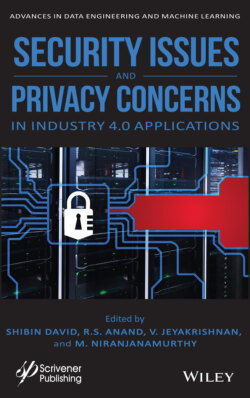Читать книгу Security Issues and Privacy Concerns in Industry 4.0 Applications - Группа авторов - Страница 4
List of Illustrations
Оглавление1 Chapter 1Figure 1.1 Comparison between the estimated world population and the projected n...Figure 1.2 Characterization of the technologies in IoT-enabled smart cities.Figure 1.3 Smart city architecture.Figure 1.4 IoT with Smart-Aqua sensors via cloud.Figure 1.5 Working of OCB in agriculture.
2 Chapter 2Figure 2.1 Network forensics process model for cloud investigation.Figure 2.2 OpenNebula: a community-based cloud management system that manages re...Figure 2.3 NetworkMiner analysis tool cloud-based forensics services.Figure 2.4 Measurement of the performance of network forensics while running clo...
3 Chapter 3Figure 3.1 Technical framework of industrial wearable system.Figure 3.2 Proposed human–physical interaction systems.Figure 3.3 Automatic speech recognition framework.Figure 3.4 LPC framework.Figure 3.5 MFCC framework.
4 Chapter 4Figure 4.1 Histogram analysis.Figure 4.2 Graph on correlation analysis.Figure 4.3 Graph of above table.Figure 4.4 Graph of above table.
5 Chapter 5Figure 5.1 Architecture of fake profile detection.Figure 5.2 Schema for identifying and understanding the fraudulent profiles.Figure 5.3 Working procedure for proposed system.Figure 5.4 Dimensionality reduction using PCA.Figure 5.5 A classification model.Figure 5.6 SVM classification for 2-Dimensional data.Figure 5.7 Random forest classifier.Figure 5.8 10-fold cross-validation for a dataset.Figure 5.9 Efficiency vs. the number of profiles belonging to the training data ...Figure 5.10 Efficiency vs. the number of attributes selected from the profile.Figure 5.11 FP (False Positive) versus the number of profiles belonging to train...Figure 5.12 FN (False Negative) versus the number of profiles belonging to train...Figure 5.13 Performance analysis of different classifiers.Figure 5.14 Evaluation metrics (Precision, Recall and F-Score) of Random Forest,...
6 Chapter 6Figure 6.1 Arrangement of sensors and Gateways in IoT-based system.Figure 6.2 Plant monitoring using IoT.Figure 6.3 ThinkSpeak dashboard.Figure 6.4 Sensor’s Reading in ThinkSpeak.Figure 6.5 Number of reached packets vs. accuracy (PDR:10%).Figure 6.6 Number of reached packets vs accuracy (PDR:20%).Figure 6.7 Number of reached packets vs. accuracy (PDR: 30%).Figure 6.8 Number of received packets vs. FN (PDR:10%).Figure 6.9 Number of received packets vs. FN (PDR:20%).Figure 6.10 Number of received packets vs. FN (PDR: 30%).Figure 6.11 Accuracy vs no. of received packets (M.N:30%) [PDR: 30%].Figure 6.12 Accuracy vs. no. of received packets (M.N:20%) [PDR: 30%].Figure 6.13 Accuracy vs no. of received packets (M.N:30%) [PDR: 20%].Figure 6.14 Accuracy vs. no. of received packets (M.N:20%) [PDR:20%].Figure 6.15 Accuracy vs. no. of received packets (M.N:30%) [PDR: 10%].Figure 6.16 Accuracy vs. no. of received packets (M.N:20%) [PDR: 10%].Figure 6.17 False alarm rate vs. no. of received packets (M.N:30%) [PDR: 30%].Figure 6.18 False alarm rate vs. no. of received packets (M.N:30%) [PDR: 20%].Figure 6.19 False alarm rate vs. no. of received packets (20%) [PDR: 30%].Figure 6.20 False alarm rate vs. no. of received packets (M.N:20%) [PDR: 20%].Figure 6.21 False alarm rate vs. no. of received packets (M.N:10%) [PDR:30%].Figure 6.22 False alarm rate vs. no. of received packets (M.N:10%) [PDR: 20%].
7 Chapter 7Figure 7.1 Proposed architecture.Figure 7.2 Working model of the system.Figure 7.3 Drone in track.Figure 7.4 Track with garbage.Figure 7.5 Open CV with drone to scan.Figure 7.6 Working of rover in track.Figure 7.7 Collection of garbage.Figure 7.8 Spraying of sanitary lotion cleaned the railway track.
8 Chapter 8Fig. 8.1 Blockchain technology.Fig. 8.2 Works timeline of blockchain technology.Fig. 8.3 Blockchain architecture’s basic components.Fig. 8.4 Blockchain architecture.Fig. 8.5 Blockchain key features.Fig. 8.6 Blockchain components.Fig. 8.7 How blockchain cryptography works.Fig. 8.8 Working of smart contracts.Fig. 8.9 Blockchain applications.Fig. 8.10 Blockchain financial and non-financial applications.Fig. 8.11 Benefits of using blockchain technology.Fig. 8.12 Limitations of implementing blockchain.Fig. 8.13 Industries that global executives believe are most advanced in blockch...Fig. 8.14 Blockchain adoption rate is gradually increasing.Fig. 8.15 Sectors currently using blockchain technology.Fig. 8.16 Barriers to large-scale adoption of blockchain.Fig. 8.17 Barriers for blockchain adoptions by 2020.
9 Chapter 9Figure 9.1 Work flow of ML-based prediction.Figure 9.2 Framework architecture.Figure 9.3 Product and former details in web portal.Figure 9.4 Web interface of proposed system.Figure 9.5 Price prediction using linear regression.Figure 9.6 Price prediction using random forest.
10 Chapter 10Fig. 10.1 resnet50 model architecture.Fig. 10.2 CNN model architecture.Fig. 10.3 Model accuracy vs. epoch.Fig. 10.4 Model loss vs. epoch.
11 Chapter 11Figure 11.1 Architecture of MAS.Figure 11.2 Dynamic nature of agents in MAS.Figure 11.3 Use case diagram for case study.Figure 11.4 Sequence diagram for the case study.Figure 11.5 Deployment diagram for case study.Figure 11.6 Arrival rate of requests versus workload on Interface Agent.Figure 11.7 Arrival time of requests versus workload on Information Agent.Figure 11.8 Arrival rate of requests versus workload on Work Agent.Figure 11.9 Arrival time of requests versus Response time.Figure 11.10 Sensitivity analysis for Response Time.Figure 11.11 Sample screen shots for Proposed Algorithm.Figure 11.12 Sample screen shots for Random Selection Algorithm.Figure 11.13 Average response time comparison using normal distribution.Figure 11.14 Average waiting time comparison using normal distribution.Figure 11.15 Average utilization comparison using normal distribution.Figure 11.16 Average response time comparison using poisson distribution.Figure 11.17 Average waiting time comparison using poisson distribution.Figure 11.18 Average utilization comparison using poisson distribution.Figure 11.19 Average response time comparison using exponential distribution.Figure 11.20 Average waiting time comparison using exponential distribution.Figure 11.21 Average utilization time comparison using exponential distribution.
